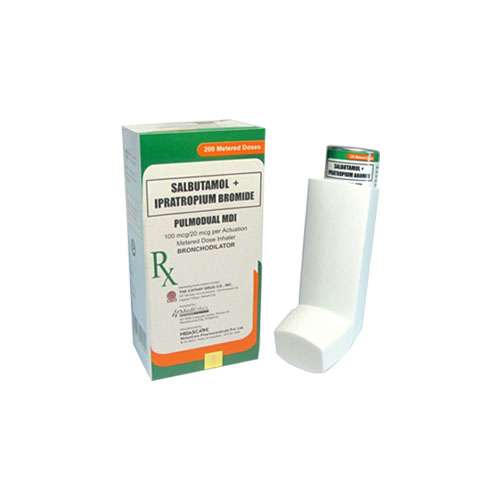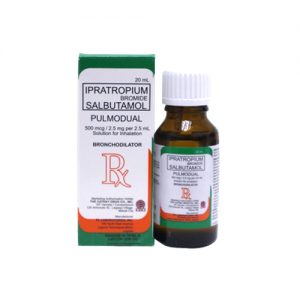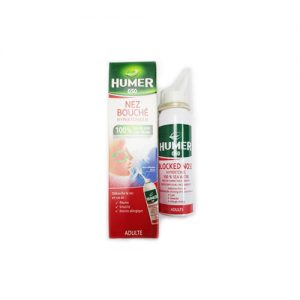Description
The Cathay Drug Co., Inc.
FORMULATION
Each actuation delivers:
Salbutamol sulphate, BP (equivalent to Salbutamol)…………… 100 mcg
Ipratropium bromide, BP ………………… ………………………… 20 mcg
Ethanol, BP ………………………………………………………… (1.0%w/v)
Product Description
Pressurized metered-dose preparation for inhalation filled in aluminum canister crimped with suitable metered-dose valve, labelled with product label, assembled with polypropylene, adaptor packed in a folding carton along with patient information label.
PHARMACODYNAMICS/PHARMACOKINETIC
PHARMACODYNAMIC PROPERTIES
Pharmacotherapeutic group: Selective beta-2-adrenoreceptor agonist and anticholinergics
Mechanism of Action
Salbutamol Sulphate and Ipratropium bromide inhalation contains salbutamol sulphate and Ipratropium bromide which have differing modes of action. The respective mechanisms of action are listed below:
Salbutamol
Salbutamol is a short-acting, selective beta-2-adrenergic receptor agonist used in the treatment of asthma and COPD. It is 29 times more selective for beta 2 receptors than beta 1 receptors giving it higher specificity for pulmonary beta receptors versus beta 1 adrenergic receptors located in the heart. Salbutamol is formulated as a racemic mixture of the R- and S-isomers. The R-isomer has 150 times greater affinity for the beta-2-receptor than the S-isomer and the S-isomer has been associated with toxicity. This lead to the development of levalbuterol, the single R-isomer of salbutamol. However, the high cost of levalbuterol compared to salbutamol has deterred wide-spread use of this enantionmerically pure version of the drug. Salbutamol is generally used for acute episodes of bronchospasm caused by bronchial asthma, chronic bronchitis and other chronic bronchopulmonary disorders such as chronic obstructive pulmonary disorder (COPD). It is also used prophylactically for exercise-induced asthma.
Salbutamol stimulates beta-2-adrenergic receptors. Binding of Salbutamol to beta-2-receptors in the lungs results in relaxation of bronchial smooth muscles. It is believed that salbutamol increases cAMP production by activating adenyl cyclase, and the actions of salbutamol are mediated by cAMP. Increased intracellular cyclic AMP increases the activity of cAMP-dependent protein kinase A, which inhibits the phosphorylation of myosin and lowers intracellular calcium concentrations. A lowered intracellular concentration leads to a smooth muscle relaxation and bronchodilation. In addition to bronchodilation, salbutamol inhibits the release of bronchoconstricting agents from mast cells, inhibits microvascular leakage, and enhances mucociliary clearance.
Ipratropium bromide
Ipratropium bromide is an anticholinergic (parasympatholytic) agent which, based on animal studies, appears to inhibit vagally mediated reflexes by antagonizing the action of acetylcholine, the transmitter agent released at neuromuscular junctions in the lung. Anticholinergics prevent the increases in intracellular concentration of cyclic guanosine monophosphate (cyclic GMP) which are caused by interaction of acetylcholine with the muscarininc receptor on bronchial smooth muscle.
In humans, ipratropium bromide has anti-secretory properties and, when applied locally, inhibits secretions from the seromucous glands lining the nasal mucosa. Ipratropium bromide is a quaternary amine that minimally crosses the nasal mucosa. It minimally crosses the nasal and gastrointestinal membrane and the blood-brain barrier, resulting in a reduction of the systemic anticholinergic effects (e.g. neurologic, opthalmic, cardiovascular, and gastrointestinal effects) that are seen with tertiary anticholinergic amines.
PHARMACOKINETICS
Salbutamol
Salbutamol is readily absorbed from the gastrointestinal tract. It is subject to first-pass metabolism in the liver and possibly in the gut wall; the main metabolite is an inactive sulfate conjugate. Salbutamol sulphate is rapidly excreted in the urine as metabolites and unchanged drug. Salbutamol does not appear to be metabolized in the lung, therefore its ultimate metabolism and excretion after inhalation depends upon the delivery method used, which determines the proportion of inhaled salbutamol relative to the proportion inadvertently swallowed. The plasma half-life of salbutamol is 2 to 7 hours.
Ipratropium bromide
Ipratropium bromide is a quaternary amine. It is not readily absorbed into the systemic circulation either from the surface of the lung or from the gastrointestinal tract as confirmed by blood level and renal excretion studies.
Autoradiographic studies in rats have shown that Ipratropium bromide does not penetrate the blood-brain barrier. The half-life of elimination is about 2 hours after inhalation or intravenous administration. Ipratropium bromide is minimally bound (0 to 9% in vitro) to plasma albumin and acid glycoprotein. It is partially metabolized to inactive ester hydrolysis products. Following intravenous administration, approximately one-half of the dose is excreted unchanged in the urine. Single doses of Ipratropium bromide were administered intravenously, orally and by slow inhalation to ten healthy male volunteers. The plasma level after oral administration followed a low but a broad plateau persisting for several hours. After IV administration the kinetic parameters were: Vc=25.9 l, Valpha= 13.1 l, v beta= 3.38 l, t1/2 alpha =3.85 min, t1/2 beta = 98.4 min, AUC=15.0 hng/mL, kel=11.8 l/j and total clearance is 2325 mL/min. the bioavailability was 3.3% (range 0.9-6.1%) on comparing the plasma AUCs following IV and 20 mg oral administration. The cumulative renal excretion (0-24 h) after IV administration was compared with that after oral administration and inhalation. Following IV administration, the apparent systemic availability was around 2%, and after inhalation it was 6.9%. In comparison with oral placebo administration, only after IV administration was there a significant change in heart rate (from 63.7 to 90.2 beats/min). The systolic blood pressure rose from 115.1 to 119.6 mmHg and the diastolic blood pressure from 68.3 to 78.3 mmHg.
INDICATIONS
Salbutamol sulphate and Ipratropium bromide Inhalation is particularly suitable for the relief and prevention of asthma systems. It should relieve symptoms when they occur and to prevent them in circumstances recognized by the patient to precipitate an asthma attack (e.g. before exercise or unavoidable allergen exposure).
Salbutamol sulphate and Ipratropium bromide Inhalation is particularly valuable as relief medication in mild, moderate or severe asthma, provide that reliance on it does not delay the introduction and use of regular inhaled corticosteroid therapy.
DOSAGE AND ADMINISTRATION
Salbutamol sulphate and Ipratropium bromide Inhalation is for inhalation use only.
Patients should be made aware that Salbutamol sulphate and Ipratropium bromide Inhalation must be used daily for optimum benefit, even when asymptomatic.
Two inhalations four times a day. Patients may take additional inhalations as required. However, the total number of inhalations should not exceed 12 in 24 hours.
Instruction for use:
Patients should be instructed in the proper use of their inhalation. During inhalation, the patient should preferably sit or stand. The inhalation has been designed for use in a vertical position.
Testing the inhalation
Before using for the first time, patients should remove the mouthpiece cover by gently squeezing the sides of the cover, shake the inhalation well. Hold the inhalation between the fingers and thumb with your thumb at the base, below the mouthpiece and release puffs into the air to make sure that it works. The inhalation should be shaken immediately before releasing each puff. If the inhalation has not been used for a week or more remove the mouthpiece cover, the patients should shake the inhalation well and release two puffs in the air.
Use of the inhalation
CONTRAINDICATIONS
Salbutamol sulphate and Ipratropium bromide Inhalation is contraindicated in patients with hypersensitivity to any of the active substances or to the excipient
WARNINGS AND PRECAUTIONS
The management of asthma should normally follow a stepwise programme and patient response should be monitored clinically and by lung function tests.
WARNINGS
Salbutamol sulphate and Ipratropium bromide Inhalation can produce paradoxical bronchospasm that can be life-threatening. If it occurs, the preparation should be discontinued immediately and alternative therapy instituted. It should be recognized that paradoxical bronchospasm, when associated with inhaled formulations, frequently occurs with the first use of anew canister. The Salbutamol sulphate are contained in Salbutamol sulphate and Ipratropium bromide Inhalation, like other beta-adrenergic agonists, can produce a clinically significant cardiovascular effect in some patients, as measured by pulse rate, blood pressure and/or symptoms. If these symptoms occur, discontinuation of the drug may be indicated. There is some evidence from post-marketing data and published literature of rare occurrences of myocardial ischemia associated with salbutamol. In addition, beta-adrenergic agents have been reported to produce electrocardiogram (ECG) changes, such as flattening of the T wave, prolongation of the QTc interval and ST segment depression. Therefore Salbutamol sulphate and Ipratropium bromide Inhalation should be used with caution in patients with cardiovascular disorders, especially coronary insufficiency, cardiac arrhythmias and hypertension. Fatalities have been reported in association with excessive use of inhaled sympathomimetic drugs, in patients with asthma. The exact cause of death is unknown, but cardiac arrest following an unexpected development of a severe acute asthmatic crisis and subsequent hypoxia is suspected.
Immediate hypersensitivity reactions may occur after administration of ipratropium bromide or salbutamol sulphate, as demonstrated by urticarial, angioedema, rash, bronchospasm, anaphylaxis, and oropharyngeal edema. If such a reaction occurs, therapy with Salbutamol sulphate and Ipratropium bromide Inhalation should be stopped at once and alternative treatment should be considered.
Salbutamol sulphate and Ipratropium bromide Inhalation contains ipratropium bromide and, therefore, should be used with caution in patients with narrow-angle glaucoma, prostatic hyperplasia, or bladder-neck obstruction.
Preparations containing sympathomimetic amines such as salbutamol sulphate should be used with caution in patients with convulsive disorders. Hyperthyroidism, or diabetes mellitus and in patients who are usually responsive to sympathomimetic amines. Beta-adrenergic agents may also produce significant hypokalemia in some patients (possibly through intracellular shunting) which has the potential to produce adverse cardiovascular effects. The decrease in serum potassium is usually transient, not requiring supplementation.
Salbutamol sulphate and Ipratropium bromide Inhalation has not been studied in patients with hepatic or renal insufficiency. It should be used with caution in those patient populations.
Information for patients
Patients should be cautioned to avoid spraying the aerosol in their eyes and be advsed that this may result in precipitation or worsening of narrow-angle glaucoma, mydriasis, increased intraocular pressure, acute eye pain or discomfort, temporary blurring of vision, visual halos or colored images in association with red eyes from conjunctival and corneal congestion. Patients should also be advised that should any combination of these symptoms develop, they should consult their physician immediately.
The action of Salbutamol sulphate and Ipratropium bromide Inhalation should last 4 to 5 hours or longer. Salbutamol sulphate and Ipratropium bromide Inhalation should not be used more frequently than recommended. Do not increase the dose or frequency of Salbutamol sulphate and Ipratropium bromide Inhalation without consulting your physician. If you find that treatment with Salbutamol sulphate and Ipratropium bromide Inhalation becomes less effective for symptomatic relief, your symptoms become worse and/or you need to the use the product more frequently than usual, medical attention should be sought immediately. While you are taking Salbutamol sulphate and Ipratropium bromide Inhalation, other inhaled drugs should be taken only as directed by the physician. If the patient is pregnant or nursing, contact the physician about use of Salbutamol sulphate and Ipratropium bromide Inhalation. Appropriate use of Salbutamol sulphate and Ipratropium bromide Inhalation includes an understanding of the way it should be administered. Since dizziness, accommodation disorder, mydriasis, and blurred vision may occur with use of Salbutamol sulphate and Ipratropium bromide Inhalation, patients should be cautioned about engaging in activities requiring balance and visual acuity such as driving a car or operating appliances or machinery.
Precautions
Before using the product, inform the physican or pharmacist for any allergies with salbutamol or ipratropium or any other allergies. Inform the physician of the patient medical history, especially patients with diabetes, heart disease (e.g. irregular heartbeat, coronary insufficiency) high blood pressure, glaucoma, low potassium blood level (hypokalemia), seizure, overactive thyroid (hyperthyroidism), urination problems (e.g. due to enlarged prostate, urinary retention).
The drug may make the patient feel dizzy. If accidentally sprayed into the eyes, it may also cause temporary blurred vision.
Do not drive, use machinery or do any activity that requires alertness or clear vision until the patient is sure that they can perform such activities safely. Limit alcoholic beverages.
Pregnancy
Pregnancy category C
There are no adequate and well-controlled studies of Salbutamol sulphate and Ipratropium bromide Inhalation in pregnant women. Animal reproduction studies have not been conducted with Salbutamol sulphate and Ipratropium bromide Inhalation. However, Salbutamol sulphate has been shown to be teratogenic in mice and rabbits.
Salbutamol sulphate and Ipratropium bromide Inhalation should be used during pregnancy only if the potential benefit justifies the potential risk to the fetus.
No evidence of abnormalities have been reported in women receiving salbutamol during pregnancy. Salbutamol has been given systemically to inhibit preterm labor. Use of salbutamol in pregnant women for relief of bronchospasm may interfere with uterine contractility.
Pulmonary edema has been associated with intravenous use of salbutamol in pregnant women. Metered dose inhalations employ lower doses and result in lower plasma concentrations following administration, thereby producing fewer adverse effects for the mother and fetus. Ipratropium has failed to reveal evidence of teratogenicity in animal studies. There are no controlled data in human pregnancy. Salbutamol sulphate and Ipratropium bromide Inhalation is only recommended for use during pregnancy where there are no alternatives and benefit outweighs risk.
Lactation
The components of Ipratropium bromide +Salbutamol are excreted in human milk. Although lipid-soluble quaternary bases pass into breast milk, it is unlikely that ipratropium bromide would reach the infant to an important extent, especially when taken by inhalation as a nebulized solution. However, caution should be exercised when administering to a nursing mother.
UNDESIRABLE EFFECTS
Headache, nausea, nervousness, trouble sleeping, dizziness, dry mouth/throat, coughing or runny nose may occur. If any of these effects persis or worsen, inform the physician promptly.
Rarely, this medication has caused severe (rarely fatal), sudden worsening of breathing problems/ asthma (paradoxical bronchospasm). Seek immediate medical attention if the patient has trouble breathing or experience sudden wheezing.
A serious allergic reaction to this drug is rare. Seek immediate medical attention if you notice any symptoms of serious allergic reaction, including rash, itching/swelling (especially of the face/tongue/throat), severe dizziness, trouble breathing.
SYMPTOMS AND TREATMENT OF OVERDOSAGE
There are no data available from clinical trials on overdose with Salbutamol sulphate and Ipratropium bromide Inhalation. However, data on overdose with both drugs are listed below:
The signs and symptoms of salbutamol overdose are chest pain, high blood pressure (hypertension) or low blood pressure (hypotension), fast heart rate (tachycardia), nervousness, headaches, shakiness(tremor), dry mouth, feelings of a rapidly or forcefully beating heart (heart palpitations), nausea, dizziness, insomnia, seizures, irregular heart rhythm (arrhythmia), fatigue, low potassium in the blood (hypokalemia) cardiac arrest, loss of life. Seek immediate medical attention when there is a case of overdosage.
No symptoms specific to overdosage of ipratropium bromide have been encountered. In view of the wide therapeutic window and topical administration of ipratropium bromide, no serious anticholinergic symptoms are to be expected. As with other anticholinergics, dry mouth, visual accommodation disturbances and tachycardia would be the expected signs and symptoms of overdose.
DRUG INTERACTIONS
Do not start, stop or change the dosage of the medicine before checking with the healthcare professionals.
- Anticholinergic agents: Co – administration of other anticholinergic containing drugs must be avoided. It can cause an additive interaction upon concomitant use of anticholinergic medications.
- Beta-adrenergic agents: Caution is advised in the co-administration of Ipratropium bromide +Salbutamol and other sympathomimetic agents due to the increased risk of adverse cardiovascular agents.
- Beta-receptor blocking agents: Beta-receptor blocking agents and salbutamol inhibit the effect of each other, it should be used with caution in patients with hyper reactive airways
- Cardiac glycosides: salbutamol possibly reduces plasma concentration of digoxin
- Diuretics: increased risk of hypokalemia when high doses of beta2 sympathomimetics is given with diuretics (e.g. loop or thiazide diuretics)
- Monoamine oxidase inhibitors or tricyclic antidepressants: it should be administered with extreme caution to patients treated with monoamine oxidase inhibitors or tricyclic antidepressants or within two weeks of discontinuation of such agents because the action of salbutamol sulphate on the cardiovascular system may be potentiated.
- Theophylline: increased risk of hypokalemia when high doses of beta2 sympathomimetics is given with theophylline.
STORAGE
Store at temperatures not exceeding 30°C.
Keep out of reach of children. Do not freeze.
Pressurized canister. Do not puncture or burn even when apparently empty. Keep away from sunlight and heat. Protect from moisture. Keep away from the eyes.
Salbutamol sulphate and Ipratropium bromide inhalation should be stored horizontal or in an inverted position, with the mouthpiece pointing downwards.
AVAILABILITY
Ipratropium bromide +Salbutamol (Pulmodual MDI) alumium canister with pump actuator x 12 g in a box.
Manufactured by
MidasCare Pharmaceuticals Pvt., Ltd.
B-16, MIDC Waluj, Aurangabad, India
Marketing Authorization Holder
The Cathay Drug Co., Inc.
2/F Vernida I Condominium, 120 Amorsolo St. Legaspi Village, Makati City
Date of revision: July 2019






Reviews
There are no reviews yet.